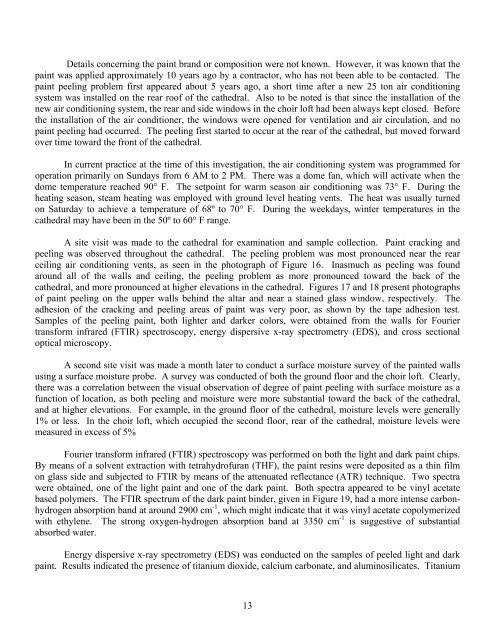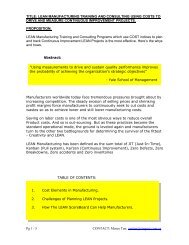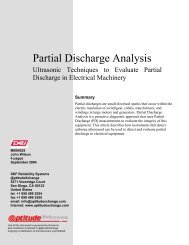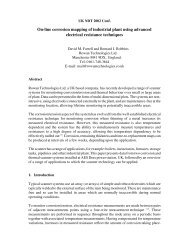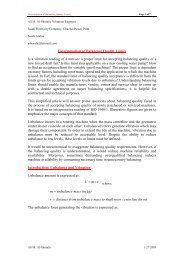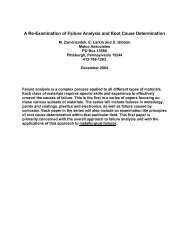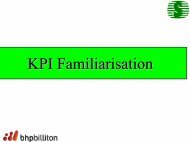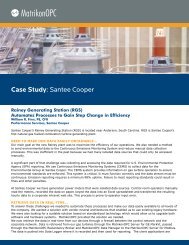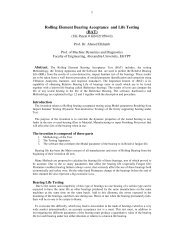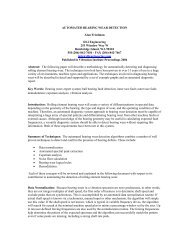Failure Analysis of Paints and Coatings - Plant Maintenance ...
Failure Analysis of Paints and Coatings - Plant Maintenance ...
Failure Analysis of Paints and Coatings - Plant Maintenance ...
Create successful ePaper yourself
Turn your PDF publications into a flip-book with our unique Google optimized e-Paper software.
Details concerning the paint br<strong>and</strong> or composition were not known. However, it was known that thepaint was applied approximately 10 years ago by a contractor, who has not been able to be contacted. Thepaint peeling problem first appeared about 5 years ago, a short time after a new 25 ton air conditioningsystem was installed on the rear ro<strong>of</strong> <strong>of</strong> the cathedral. Also to be noted is that since the installation <strong>of</strong> thenew air conditioning system, the rear <strong>and</strong> side windows in the choir l<strong>of</strong>t had been always kept closed. Beforethe installation <strong>of</strong> the air conditioner, the windows were opened for ventilation <strong>and</strong> air circulation, <strong>and</strong> nopaint peeling had occurred. The peeling first started to occur at the rear <strong>of</strong> the cathedral, but moved forwardover time toward the front <strong>of</strong> the cathedral.In current practice at the time <strong>of</strong> this investigation, the air conditioning system was programmed foroperation primarily on Sundays from 6 AM to 2 PM. There was a dome fan, which will activate when thedome temperature reached 90° F. The setpoint for warm season air conditioning was 73° F. During theheating season, steam heating was employed with ground level heating vents. The heat was usually turnedon Saturday to achieve a temperature <strong>of</strong> 68º to 70° F. During the weekdays, winter temperatures in thecathedral may have been in the 50º to 60° F range.A site visit was made to the cathedral for examination <strong>and</strong> sample collection. Paint cracking <strong>and</strong>peeling was observed throughout the cathedral. The peeling problem was most pronounced near the rearceiling air conditioning vents, as seen in the photograph <strong>of</strong> Figure 16. Inasmuch as peeling was foundaround all <strong>of</strong> the walls <strong>and</strong> ceiling, the peeling problem as more pronounced toward the back <strong>of</strong> thecathedral, <strong>and</strong> more pronounced at higher elevations in the cathedral. Figures 17 <strong>and</strong> 18 present photographs<strong>of</strong> paint peeling on the upper walls behind the altar <strong>and</strong> near a stained glass window, respectively. Theadhesion <strong>of</strong> the cracking <strong>and</strong> peeling areas <strong>of</strong> paint was very poor, as shown by the tape adhesion test.Samples <strong>of</strong> the peeling paint, both lighter <strong>and</strong> darker colors, were obtained from the walls for Fouriertransform infrared (FTIR) spectroscopy, energy dispersive x-ray spectrometry (EDS), <strong>and</strong> cross sectionaloptical microscopy.A second site visit was made a month later to conduct a surface moisture survey <strong>of</strong> the painted wallsusing a surface moisture probe. A survey was conducted <strong>of</strong> both the ground floor <strong>and</strong> the choir l<strong>of</strong>t. Clearly,there was a correlation between the visual observation <strong>of</strong> degree <strong>of</strong> paint peeling with surface moisture as afunction <strong>of</strong> location, as both peeling <strong>and</strong> moisture were more substantial toward the back <strong>of</strong> the cathedral,<strong>and</strong> at higher elevations. For example, in the ground floor <strong>of</strong> the cathedral, moisture levels were generally1% or less. In the choir l<strong>of</strong>t, which occupied the second floor, rear <strong>of</strong> the cathedral, moisture levels weremeasured in excess <strong>of</strong> 5%Fourier transform infrared (FTIR) spectroscopy was performed on both the light <strong>and</strong> dark paint chips.By means <strong>of</strong> a solvent extraction with tetrahydr<strong>of</strong>uran (THF), the paint resins were deposited as a thin filmon glass side <strong>and</strong> subjected to FTIR by means <strong>of</strong> the attenuated reflectance (ATR) technique. Two spectrawere obtained, one <strong>of</strong> the light paint <strong>and</strong> one <strong>of</strong> the dark paint. Both spectra appeared to be vinyl acetatebased polymers. The FTIR spectrum <strong>of</strong> the dark paint binder, given in Figure 19, had a more intense carbonhydrogenabsorption b<strong>and</strong> at around 2900 cm -1 , which might indicate that it was vinyl acetate copolymerizedwith ethylene. The strong oxygen-hydrogen absorption b<strong>and</strong> at 3350 cm -1 is suggestive <strong>of</strong> substantialabsorbed water.Energy dispersive x-ray spectrometry (EDS) was conducted on the samples <strong>of</strong> peeled light <strong>and</strong> darkpaint. Results indicated the presence <strong>of</strong> titanium dioxide, calcium carbonate, <strong>and</strong> aluminosilicates. Titanium13


